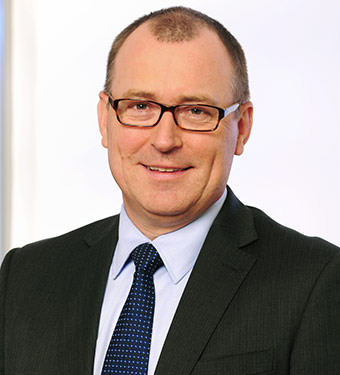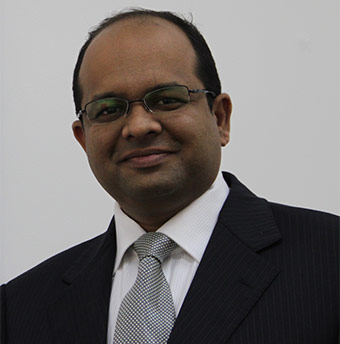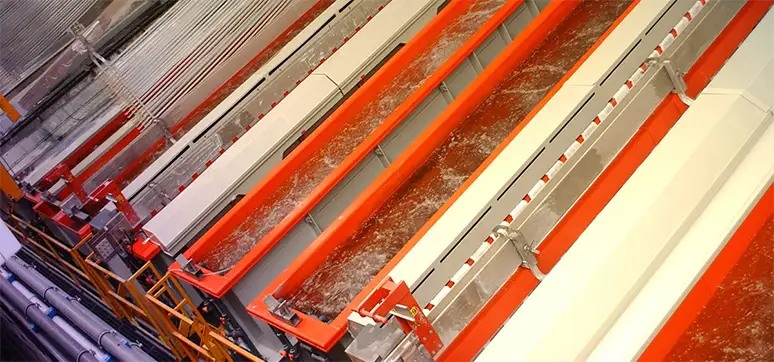
Extruded aluminium is the material of choice for countless applications and architecture accounts for 12-15% of the total aluminium consumed in the world. To ensure satisfactory performance all these products require modification of the surface which can be carried out after the material has been formed to the final shape.
As reinstated in the earlier section of the feature, aluminium surface finish involves three stages –
- Cleaning
- Pre-treatment
- Coating
In order to have a deeper understanding of the pre-treatment process, its importance and the level of acceptance in the Indian context, we requested Mr Stephan Zegers to spare some time and give us an insight into this extremely important component of aluminium finishing. Mr. Zegers manages Alufinish GmbH and is an expert in the field of Aluminium Surface treatment with an experience of about two decades. During his recent visit to India along with Mr. Abdul Saleem, who handles the Middle East and Asian markets, WFM had a Q&A session with them. Here are the excerpts:
What is Alufinish India? How is it the part of façade industry?
Alufinish GmbH & Co. KG is a forty-two-year-old company based in Germany, with operations in 40 countries worldwide in the field of metal surface treatment. Since inception, we have been successfully developing, producing and distributing the products for surface treatment of metals such as aluminium, steel and iron.
Our expertise is focused on anodizing of aluminium, aluminium pre-treatment for coating, and pre-treatment of Iron and steel in addition to multimetal pre-treatment along with some specialized processes. Amongst the various market segments that our company caters to, the building industry or architectural aluminium is one.
How does correct pre-treatment contribute to building a sustainable façade?
SZ: In general for any product which goes for research and development before being launched in the market, there are a number of drivers –
- Safety, health and environment,
- Cost
- Quality in the broadest sense of the word.

Mainly, we at Alufinish try to bring out products which have less impact on the environment. We strive to develop the greenest possible technology available. However, unfortunately, there are no regulations so far for the applicators urging them not to use non-environment-friendly products like hexavalent chrome (or chrome VI as it is commonly called) – which is one of the most hazardous materials for human consumption. The chrome-rich mist above the process bath is inhaled and can get accumulated on the organs of the workers which can lead to cancer and various other detrimental diseases.
WFM: So is Alufinish totally chrome-free?
SZ: You can say we can offer complete chrome free solutions as per the demand. But since the market is still allowed to use chrome and there is a demand for the same, we do offer the conventional solutions. However, our constant endeavour is to provide the most technologically advanced products which are pro-human safety and environment friendly
I would like to relate an incident here – I had a short talk with this gentleman from Delhi who’s building a new plant. The area where he plans to have this coating line is not allowed to use hexavalent chrome. This is a positive sign and such measures will encourage us all – the suppliers as well as the applicators to use better, friendlier products.
With European REACH (Registration Authorization, Restriction and Chemicals) now gearing up for a complete ban on chrome products, how will it impact global use of chrome based pre-treatment chemicals? And what impact will it have on the final quality of the finish?
SZ: It’s legislation from the European community. Qualicoat since 96-95 allows the use of alternative systems other than hexavalent chrome viz. chromate phosphate, also called green chrome. But before an applicator can use it, one has to pass a number of tests. Once the product gets all the necessary approvals only then a user can be confident of the quality to be achieved from it. End result of such an application of chrome free pre-treatment in terms of corrosion performance, adhesion performance and impact performance is exactly the same as that of conventional processes. So we can say there is no need to use chrome – 6 anymore. We have the environmentally friendly alternative ready.
What is your personal preference – powder coating, anodizing or PVDF?
SZ: Well, that’s difficult. You can’t ask a father to choose between his daughters. How can I say I love my elder daughter more than the younger? Objectively speaking, going by an architect’s vision,I would say powder coating. The colour choices that powder coating offers are enormous. As long as the powder is also qualicoat approved, all the colours of the rainbow are possible. And Powder coating is also a UV-resistant option.
From technical point of view, anodizing is an exceptionally good surface treatment. But there is a limited range of UV-resistant products.
Mr. Saleem, how is the Indian market responding when it comes to choosing right pre-treatment and better-quality products?
AS: The booming real estate market and the use of pre-fabricated structures do offer an unprecedented opportunity for us to grow the business. Today industries in India are more quality-conscious than before. They are ready to go the proverbial extra mile to meet the international standards. More and more companies are going for Qualicoat, Qualanod and Qualideco certifications and what we are bringing to the table is unmatched quality, backed by industry standards and global expertise. We are receiving a very positive response from the industry. The Indian market is of strategic importance to us and over the past couple of years, we have been investing in resources and infrastructure in this market in terms of sales and marketing, and customer support. Depending on its applications, durability and purpose, the pre-treatment choice differs but we are equipped with all relevant systems to fulfil any such demand that may arise.
How’s the cost consciousness of the Indian market accepting the chrome-free and environmentally friendly products, processed
AS: If you look into the total cost factor, there is not much of a difference from the conventional chromating process. At the end, one saves more than 30% on water and chemicals.With strict control the process is simpler with a bare minimum requirement for effluent treatment. However, there is always a natural resistance to any change and so is expected in this case also. But once the consumer is aware and understands its basics and importance, he is more than willing to spend that little extra to save the environment.
Apart from achieving better aesthetics and corrosion resistance what other factors are important?
SZ: The most important is treating the right alloy. I want to go one step back here. In my experience – the Indian market is always talking about 2 segments – the internal Indian market and the export market. I want to urge the users they should abandon this idea and go for one quality that is the best quality. And that’s not really an expensive proposition. You just have to adopt it. If your profile is going to be corroded and has to be replaced in a couple of years than the cost incurred will be a lot more than a well pre-treated profile which has undergone a proper quality process. I would like to request users to step away from this idea, and you shall create a more sustainable industry.
Let’s strive for one world, one quality














